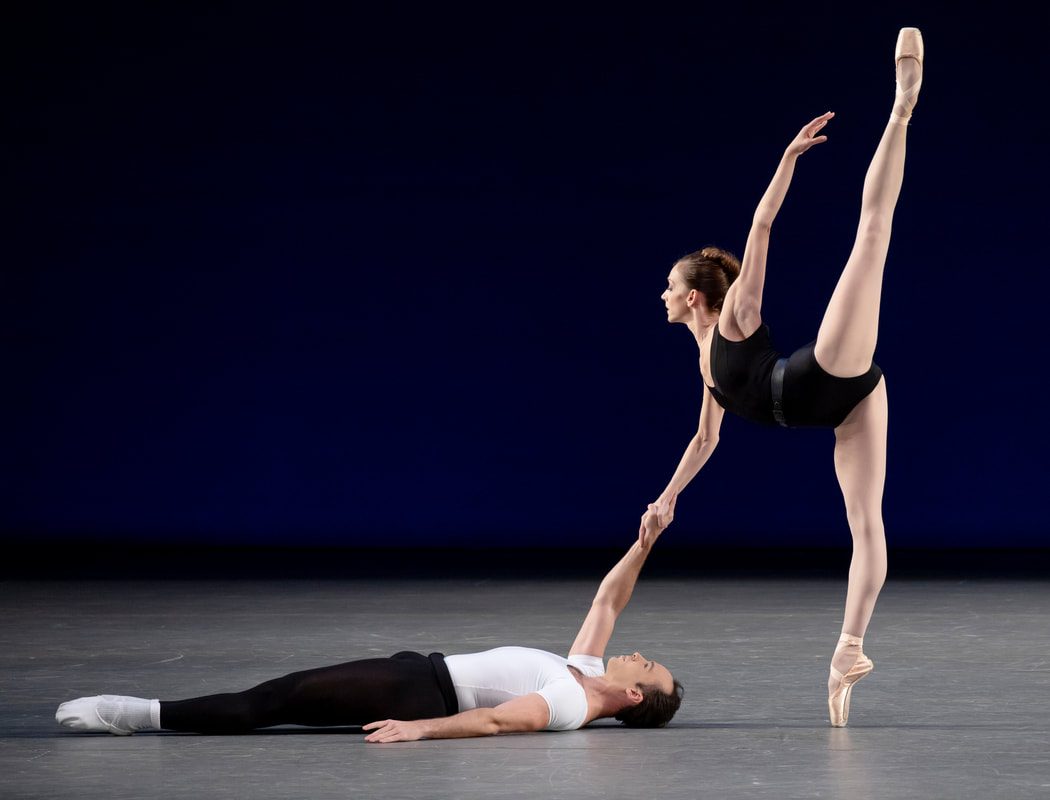|
The pas de deux from George Balanchine's "Agon" from 1957 is complex and revolutionary for the art of ballet. What a difference a day makes.
While I’m still not thrilled with New York City Ballet’s pandemic-inspired lecture-demonstration format during its brief stay at Saratoga Performing Arts Center this week, Thursday afternoon’s “All Balanchine” version seemed less awkward. And happily, more enjoyable. Multiple departures from Wednesday’s program, though slight, made for the happy difference. First Gonzalo Garcia was host. Unlike Maria Kowroski who read from index cards, Garcia was speaking extemporaneously, pacing the stage like a motivational speaker, signaling the audience must hang on every word. We did. And then there were the excerpts – they were longer – only slightly. But that little extra moment to savor the dance was precious. It was exactly what we needed in order to feel like yes, we are at the ballet. Moreover, the snippets from company founder and genius choreographer George Balanchine’s “Apollo” “Four Temperaments,” “Agon” are unadorned. None of them have the elaborate sets or are backed up with slews of corps de ballet dancers. So two dancers on stage was ideal, unlike on Wednesday night’s showing of story ballets excerpts. Design and dancers were sorely missing. Thus Balanchine’s neoclassical excerpts felt more complete and audience did not feel cheated out of an experience. And the dancers, as usual, were superb. It’s amazing to note that they have not danced in front of an audience since the start of the pandemic. But they performed beautifully, each with precision, careful to point out how special – and in some cases revolutionary – Balanchine ballets were and remain. The afternoon started with the variations performed by Apollo’s three muses with the supple Teresa Reichlen as Terpsichore. Her variation, a show of the muse’s artistry, devotion and affability, was enchanting for the mix of emotions it inspired. And Reichlen, now a senior dancer, has the ability to draw out every ounce of meaning in every step and gesture. Equally wonderful were Miriam Miller and Amar Ramasar in the complex “Agon” pas de deux. As one watches the intertwining of arms and legs and their miraculous unraveling, one can’t help but wonder how the classical trained Balanchine came up with such radical movement. While he was an insurgent, Balanchine was also a showman. In excerpts from the triptych “Jewels,” “Emeralds,” “Rubies” and “Diamonds,” and “Who Cares,” Balanchine’s love for making music visible was clear. “Diamonds” was especially glorious with Miller and Tyler Angle – the approach walking and circling each other is tentatively, but revealing the draw that they eventually surrendered to was sumptuous. And though I’m not a huge fan of “Who Cares,” the dancing – with the men strutting and the women skipping – was uplifting. Certainly, the company is leaving us wanting for more. This program will be repeated at 7:30 p.m. Friday and Saturday, July 16 and 17, at Saratoga Performing Arts Center.
0 Comments
Leave a Reply. |
Wendy
|

 RSS Feed
RSS Feed
